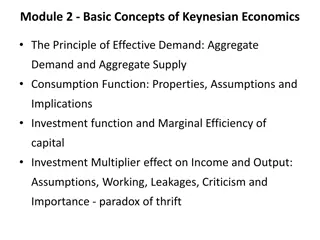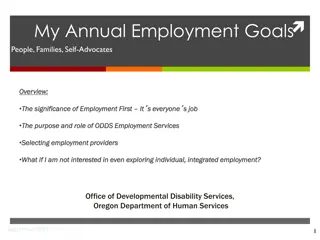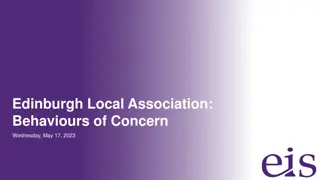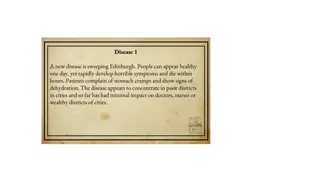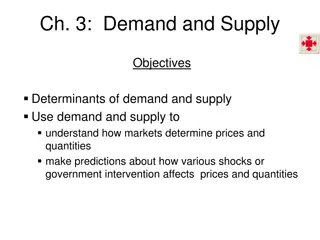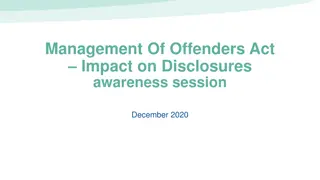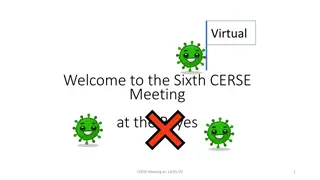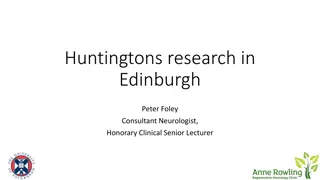Insights into Industry and Employment Skills Demand in Edinburgh and South East Scotland
Understanding the economic indicators, regional economy, top employing sectors, and projected growth in employment levels in Edinburgh and South East Scotland. Dive into the Gross Value Added (GVA), productivity measures, and workforce trends shaping the region's economic landscape.
Download Presentation

Please find below an Image/Link to download the presentation.
The content on the website is provided AS IS for your information and personal use only. It may not be sold, licensed, or shared on other websites without obtaining consent from the author.If you encounter any issues during the download, it is possible that the publisher has removed the file from their server.
You are allowed to download the files provided on this website for personal or commercial use, subject to the condition that they are used lawfully. All files are the property of their respective owners.
The content on the website is provided AS IS for your information and personal use only. It may not be sold, licensed, or shared on other websites without obtaining consent from the author.
E N D
Presentation Transcript
Industry and Employment Skills Demand Edinburgh and South East Scotland LMI Toolkit Skills Development Scotland 2020-2021
The Edinburgh and South East Scotland LMI Toolkit The purpose of the three slide decks included within the LMI Toolkit is to aid your understanding of Labour Market Information. These slide decks operate as an information pack to assist your interpretation and understanding of labour market indicators and to allow you to explore labour market data independently as it emerges. Please note that the slide decks do not provide up to date, real time information. The slide decks have been populated withsample data and only reflect a specific moment in time. You are encouraged to use the sources provided within the notes to access the most up to date data from SDS publications, such as the RSA Data Matrix, Regional Skills Assessments and the Sector Skills Assessments. You can also use the interactive ESES LMI Map to identify any relevant labour market publications that may support your understanding of wider changes in the labour market. Please use the notes provided as you work your way through the slide decks to assist your learning and identify the relevant sources.
Contents Regional Economy Industry and Employment Local Business Base Growth Sectors Industry Perspective Unemployment Scottish Government and SDS Response SOC and SIC codes explained Please use the notes contained under each slide to assist the reading of this slide pack and use the SOURCE in the notes to find additional data.
The Regional Economy Economic indicators give us a good idea of a region s economic performance and hints at the types of sectors that may contribute to the regions economic footprint. These indicators include: Gross Value Added (GVA) measures sectoral economic contributions to the regional economy Productivity measures how much the average individual contributes to the regional economy Example 1 Edinburgh and South East Scotland Gross Value Added (GVA) Productivity Edinburgh and South East City Deal productivity 2020: 51,600 in Scotland it was 45,500 Total Edinburgh and South East City Deal GVA 2020: 38,365m and 30% of total Scottish output A decrease across Edinburgh and South East City Deal from 2010-2020 of 4.9% or 2,200 From 2010-2020, GVA in Edinburgh and South East City Deal increased by 7.5% Forecast average annual growth (2020-2030) Edinburgh and South East City Deal: 1.8% Scotland: 1.9% United Kingdom: 2.0% Forecast average annual growth (2020-2030) Edinburgh and South East City Deal: 2.4% Scotland: 2.2% United Kingdom 2.4%
Industry and Employment Industry Top employing sectors/High growth sectors Employment Current employment levels; projected employment growth Example 2 Edinburgh and South East Scotland Industry in 2020 Employment in 2020 Top employing industries in 2020 In 2020, there were 702,100 people employed in Edinburgh and South East Scotland. Education However the workforce is anticipated to contract by 0.4% over the year due to COVID-19. Human health activates Retail trade, except of motor vehicles By 2030 the workforce is anticipated increase to 739,100 an increase of 2.8% or 20,400 people from 718,700 in 2023. Public administration and defence Industries with the largest forecast growth to 2030: This is a higher in comparison to Scotland with a 1.1% increase of 30,300 people. Wholesale and retail trade Human health and social work *If you would like to learn more about the impact of COVID-19 on the region, please visit the COIVD-19 LMI Insights, Regional Skills Assessment (RSA) Data Matrix and the RSA Infographics. Administrative and support services Accommodation and food services
Sectoral Skills Assessments (SSA) Infographics Key Sectors across Scotland current & future Skills Demand: Evidence and Industry expert insight covering Click on the icon to visit the Sectoral Skills Assessment Social Care Health Care Engineering Construction Childcare Digital Financial Services Food & Drink Life & Chemical Science Tourism Energy Creative
Local Business Base Example 3 Edinburgh and South East Scotland Analysis of the local economy may show disparities across regions and in some cases, potential inequalities. These differences could include salaries by sector and gender; full-time vs part time working and distribution by business size. As of December 2020, there were 81,300 self employed individuals in Edinburgh and South East Scotland (11.9%). Weekly median gross pay for full time workers in Edinburgh and South East Scotland (2020) Area Male FT Workers Female FT Workers Total FT Workers 708.90 599.50 641.10 City of Edinburgh The Scottish Borders had the highest rate of self employment at 22.7% compared to Midlothian with the lowest rate at 7.0%. 640.00 520.00 596.00 East Lothian 595.30 561.00 579.20 Fife 629.50 506.90 556.80 Midlothian The region is also made up of 43,740 small businesses making the business base vulnerable to external shocks in the labour market, such as COVID-19. 566.90 456.10 521.50 Scottish Borders 608.40 554.60 591.70 West Lothian 626.30 562.50 595.00 Scotland Gender divisions Across all local authorities, men have higher weekly earnings than women. Women also have lower weekly earnings than the national average. This is because historically, women tend to take on the bulk of domestic caring responsibilities and are employed in part time, lower paid positions. 88% 44,690 Number of Businesses in 2020 are small businesses with less than 10 employees
What are Growth Sectors? Growth Sectors are those identified by the Scottish government as having the potential to grow making Scotland more economically competitive (high GVA). Industries with the potential to grow and make Scotland more competitive This creates more opportunities for people in Scotland + = But in order to grow industries need people with the right skills, qualifications and fresh ideas. Scotland s Economic Strategy1 identifies the following sectors where in Scotland has a distinct comparative advantage: Every region has it s own growth sectors2 Some sectors like Sustainable Tourism or Life Sciences have jobs spread across Scotland, others like Energy tend to have a higher share of Growth Sector jobs in particular cities, regions or local authorities. Food and drink (inc. agriculture and fisheries) Creative industries (including digital) For example, Sustainable Tourism was the largest employing growth sector in East Lothian in 2019 however, in West Lothian the largest employing growth sector was Financial and Business Services. Sustainable tourism Energy (including renewables) Financial and Business Services It is important to understand local demand to ensure people preparing for and entering the world of work, can bring important benefits to local economies. Life Sciences
The Value of Growth Sectors Example 4 Edinburgh and South East Scotland Gross Value Added (GVA) Per Head Employment ( ) 2018 Employment by Local Authority Area and Growth Sector: Edinburgh and South East Scotland 2019 GVA measures the contribution made to an economy by one individual sector or region. It is a numerical assessment of the value of goods and services produced. Financial and Business Services 79,000 Sustainable Tourism (Tourism related industries) 63,000 Energy - 422,458 Creative Industries - 365,595* Creative Industries (including digital) 28,475 Financial and business services - 331,061 Food and Drink 17,450 Life Sciences- 167,106 Food and Drink - 237,446 Life Sciences 6,800 Sustainable Tourism 110,439 *The Creative Sector GVA per head is substantially above the Scottish average ( 59,547) though it has less than half the jobs (90,000). Energy (including renewables) 8,100
Industry Perspective (Scotland) Scottish Employer Perspective Survey 2019 What do employers look for when they are recruiting? Some industries were more inclined to employ under 25 s than other such as Hotels and Restaurants, Wholesale and Retail, Education and Financial Services. When recruiting in 2019 62% said work experience is a significant or critical factor Industries that had a high level of recruitment of individuals over 50 were, manufacturing and Health and Social Work. 51% asked for at least SCQF level 4 or 5 in Maths and English In 2019 30% of employers recruited someone to their 1st job after leaving education. 46% looked for a relevant Vocational Qualification; and 35% wanted particular academic qualifications from Nationals to Degrees. Proportion of Employers who felt these recruits were Well or Very Well prepared for the job 78% 74% The top 3 recruitment approaches in 2019 were: 58% Word of Mouth Company Social Media Company Website 78% 56% 53% School Leavers College Leavers University Leavers
Industry Perspective (UK) What are employers looking for? How are careers changing? What skills are missing? When recruiting graduates, aptitude is considered more important than formal qualifications. It is reported that young graduates lack basic numeracy and literacy skills which can impact on day to day tasks. COVID-19 and the increase in flexible/remote working has reduced the geographical barriers associated with employment opportunities. Resilience in young people, and the ability to deal with set backs is an essential skill sought by employers. Other identified skills shortages In young people are: problem solving, communication, teamwork, analytical thinking, self management and resilience. Career paths are no longer linear with many people switching between jobs over their life time. A positive attitude to work, punctuality, flexibility and the ability to make a professional introduction are crucial when deciding to recruit a young person. Technical skills such as Block Chain, Cloud Computing, Analytical Reasoning and Artificial intelligence are also in demand amongst companies in 2020. Many employers are looking to recruit graduates from STEM subjects. Around 1/3 of employers do not have a preference for degree subject (although some careers and professions do require specific degrees and qualifications) Half of all employers report that they have not hired a young person because they felt they did not have the right attitude. Digital skills and coding skills are also in high demand and it is thought that graduates underestimate the demand for digital skills amongst recruiters and employers. Basic and technical skills are important for the application stage but personal attributes and attitudes are more important beyond the application stage. Only about 1/4 of employers consider the university that an applicant attended, for the majority of employers, this is not a consideration.
Unemployment Impact of COVID-19 on Employment: Example 5 Edinburgh and South East City Region Unemployment Universal Credit (UC) Claimants We can use more timely indicators such as the number of individuals on UC to assess the impact of changes in labour market. Unemployment rates can be driven by strategic drivers in the labour market such as COVID-19. No. of people on Universal Credit - Edinburgh and South East Scotland (2020-21) COVID-19 has increased unemployment across Scotland as well as Edinburgh and South East Scotland. Figures are for December 2020: 2nd lockdown 1st lockdown 130,000 118,617 116,359 114,322 112,379 120,000 112,819 112,103 117,041 115,157 110,000 Unemployment 16+ population Edinburgh and South East Scotland: 28,600 (4.0%) Scotland: 117,500 (4.3%) Unemployment 16-64 population Edinburgh and South East Scotland: 11,800 (16.6%) Scotland: 45,200 (13.5%) 105,815 113,007 113,423 109,774 100,000 87,958 90,000 80,000 70,000 60,000 60,556 50,000 For update to date unemployment insight please see the Regional Skills Assessments. 40,000 Possible unemployment scenarios have been modelled based on data from the Annual Population Survey (2019 denominators). They provide a rough indication of the possible unemployment challenges to come as a result of COVID-19 (rate and no. of people). 8% = 212,200 10% = 256,300 12% = 318,300 15% = 397,900 20% = 530,600 8% = 55,400 10% = 69,200 12% = 83,100 15% = 103,800 20% = 138,400 Scale of potential unemployment levels in Edinburgh and South East City Deal Scale of potential unemployment levels in Scotland
Impact on Individuals: COVID-19 Example 6 - Edinburgh and South East Scotland Furlough data Trend Analysis In Edinburgh and South East Scotland as at the 31st of March 2021 there were 84,800 people on furlough. Longer working lives due to changes to state pensions could also add to the challenges facing young people in the labour market. 41,100 were male 43,700 were female Those in low paid jobs are also more likely to be unable to work from home and could be further exposed to unemployment (IFS, 2020). Females between the ages of 16-24 across the region also have a higher rate of unemployment (15.8) compared to their male counterparts (17.5). The Institute for Public Policy Research has identified that employees from Black, Asian and Other Ethnic Minorities were nearly three times more likely to have faced redundancy as a result of the pandemic in comparison to the population as a whole. The unemployment rate for individuals from ethnic minorities across Edinburgh and the South East of Scotland is 9.1% higher than the average unemployment rate for the region (4.0%). Those with EA core or work-limiting disabilities also have higher rates of unemployment compared (4.4%). The transition to working from home may operate to disadvantage young peoples development in the workplace due to lack of opportunity to build softer meta-skills (BBC, 2020).
A responsive Career Service Tailored CIAG Support Redundancy Support Continued focus on coaching approach and development of Career Management Skills for school & post-school customers Continued support for Scottish Government s PACE partnership Enhanced digital offer and local partnership development Adapted groupwork delivery (inc development of Gaelic sessions) Direct engagement and support for school leavers Strong coordination with local services & partner programmes Innovative Digital Services Upskilling & Reskilling Job Hub National Transition Training Fund Online Learning Portal Individual Training Accounts Enhanced content for adults, pupils, parents/carers School leaver webinar programme (inc winter leavers) School returner FA broadcast Career Education Standard: Teacher & parent resources
Post-COVID-19 Apprenticeships Plan Protecting Apprentices Creating New Opportunities Managed Expansion Apprentice Retention Adaptions for physical distancing Digital innovation Grant relief learning providers FA level 4 and 5 expansion Increase GA starts Promotion to growth sectors Redundant Apprentice Support New Pathways Pathway Apprenticeships Adopt an Apprentice Apprentice Transition Plan Stimulating Demand Supporting Recovery & Futureproofing Programme Innovation Employer Engagement Public sector expansion Employer engagement Awareness Raising Skills Alignment Frameworks & Standards Embedding meta-skills Employer Incentives Industry Leadership Adopt an Apprentice Links to UK & Scottish Government incentives Scottish Apprenticeship Advisory Board New COVID-19 Intervention Enhancements to existing programmes and activities
Standard Occupational Classifications (SOC) SOC Codes are used to classify jobs in terms of their skills level and skills content. They consider: Skill level length of training or experience needed to do the job. Includes time needed to gain formal qualifications. Skills Specialisation - the field of knowledge required to do the job Type of work performed materials worked with, tools used, etc. Each classification covers a wide range of jobs allowing us to group the information. There are 9 major groups - used within the RSA s - and a further 25 sub-major groups, 90 minor groups and 369 unit groups. Full details can be found at the Office for National Statistics (ONS) or you can find out more about any group using the SOC Hierarchy Tool The nine SOC groups have been organised into three levels Highly Skilled, Mid Skilled and Low Skilled roles. This can be linked to the level of qualifications, skills and experience required. Need High-level vocational qualifications Degree or Postgraduate Substantial extra training/study Significant knowledge/experience Highly Skilled (SOC 1-3) Need Training often work-based Specialist training (Skilled Trades) Good general education Relevant skills and experience Mid Skilled (SOC 4-6) Need General education Some work-based training Some relevant skills and experience Low Skilled (SOC 7-9)
Standard Occupational Classifications (SOC) While we can t include all the sub-groups linked to the nine major SOC groups here is some additional detail on skill and qualifications linked to each major SOC with example jobs for each category. Use My WoW for further examples. High Skilled Mid Skilled Low Skilled Managers, directors & senior officials: Significant knowledge & experience. e.g. Corporate managers, directors and other managers & proprietors across all industries; shopkeepers and owners. Administrative and secretarial occupations: Good general education, some need further vocational training. e.g. government; finance; records; sales; customer service manager; office managers & supervisors; medical; legal, etc. Sales & customer service occupations: General education and work-based sales training. e.g. sales & retail assistants; debt & rent collectors; market traders; customer services, sales supervisors Professional occupations: Degree or equivalent, some need post-grad or relevant training. e.g. Professionals in: science, R&D, engineering & technology; health; teaching & education; business, media & public service; IT & finance. Process, plant and machine operatives: Knowledge & experience to operate vehicles & machinery. e.g. manufacturing; assemblers; machinists; tire, exhaust & windscreen fitters, scaffolder; road & rail construction & maintenance. Skilled trades occupations: Substantial period of training. e.g. agriculture; metal, electrical & electronic; construction & building; textile workers; printing; food prep & hospitality Caring, leisure & other service occupations: Good general education, some need further training (work-based) e.g. childcare; animal care & control; care services; leisure & travel; hair & beauty; cleaning & housekeeping managers; bed & breakfast owners. Associate professional occupations High level vocational quals & further training/study. e.g. Associates professionals in: science; engineering; tech; health & social care; childcare & education; protective services; culture, media & sports; business & public service Elementary occupations: General education short period of work-related training. e.g. farm, forestry & fishing; construction; packers, bottlers; postal workers; cleaners; security guards; shelf fillers; storage; porters, bar & waiting staff, etc.
Standard Industry Classifications (SIC) SIC Codes are used to classify businesses by type of economic activity. There are 21 sections, 88 divisions, 272 groups, 615 classes and 191 subclasses. SIC has been used within My Wow to organise information such as the job profile, however some alterations in terminology or combining of categories was needed to allow the system to work effectively. B - Mining & Quarrying A - Agriculture, forestry & fishing C - Manufacturing MyWoW: Animal, land & Environment (38) e.g. animal technician; agricultural engineer; countryside officer; dog groomer; farm manager/worker; farrier; fishing vessel skipper; environmental consultant; geoscientist; landscaper; meteorologist; vet; zookeeper... MyWoW: Manufacturing & Production (23) e.g. Brewery Worker; Distillery manager; Garment technologist; Heat Treatment Operator; Packer; Production Manager; Tailor; textile technologist; Toolmaker; Quality Manger; Upholsterer; Wood Machinist MyWoW: NOT USED too few job profiles - these appear in other classifications Geoscientist (Animal, land & Environment) Quarry Engineer (Engineering) Mineral Surveyor (construction & building) Energy Engineer (Engineering) E - Water supply, sewerage, waste management & remediation D Electricity, gas, steam & air conditioning Supply F - Construction MyWoW: NOT USED as almost all roles related to engineering e.g. Chemical Engineer; Energy Engineer; Electrical Engineering technician; Electricity Distribution Worker; Gas Service Technician; Nuclear Engineer; Heating & Ventilation Engineer MyWoW: NOT USED, too few job profiles, these appear in other classifications Leakage Operative; Water Treatment Worker (construction & Building) Refuse Collector; Recycling Operative (Facilities and property services) MyWoW: Construction & building (46) e.g. Architectural technician; Bricklayer; Civil Engineer; Building Merchant; Building Control Officer; Construction Manager; Construction Plant mechanic; Surveyor; town planner; Road Worker; Structural Engineer; Water treatment worker G - Wholesale & retail trade including repair of motor vehicles I - Accommodation & food service activities H - Transportation & storage MyWoW: Retail & customer services (27) AND garage services (8) e.g. bookmaker; call center operators; courier; retail buyer/manager; market trader; window cleaner; cycle mechanic; car salesperson; motor vehicle breakdown engineer... MyWoW: Hospitality, Catering and Tourism (25) e.g. Air Cabin Crew; Airline Customer Service Agent; Baker; Catering Manager; Counter Service Assistant; Croupier; Fairground Worker; Hotel Manager; Travel Agent; Resort Representative; Waiting Staff . MyWoW: Transportation, distribution & logistics (22) e.g. Air Traffic Controller; Baggage Handler; Bus/Coach Driver; Chauffer; Forklift Truck Operator; Freight Forwarder; Postal Delivery Workers; Removals Workers; Signaling technician; Road Transport Manager
Standard Industry Classifications (SIC) K-Financial & insurance activities J - Information & communication L - Real estate activities MyWoW: Print and Publishing (, AND Marketing and Advertising AND Computing and ICT (17) e.g. Advertising Account Executive; Bookbinder; Commissioning Editor; Image Consultant; Journalist; Market Research Data Analyst; Technical Writer; Forensic Computer Analyst; Helpdesk Professional; IT Support Technician; Games Tester... MyWoW: NOT USED as too few job profiles in this area, appear in: Estate Agent (retail & customer services) Surveyor (construction & building) Housing Officer (social work & caring services) MyWoW: Financial services ( e.g. Accounting Technician; Actuary; Bank Manager; Economist; Financial Adviser; Insurance Broker; Insurance Risk Surveyor; Investment Analyst; Management Accountant; Tax Inspector O - Public administration & defence: compulsory social security N - Administrative & support service activities M - Professional, scientifc & technical activities MyWoW: legal & court services (11) AND Science, mathematics & statistics (23) some activities appear in other areas: Architectural Activities in Construction. e.g. advocate; paralegal; patent attorney; solicitor; astronaut; botanist; cartographer; food scientist; data analyst-statistician; geneticist; marine biologist MyWoW: Security, uniformed & protective services (28) e.g. armed service officer; assistant immigration officer; bodyguard; CCTV operator; coastguard; criminal intelligence analyst; firefighter; merchant navy; private investigator; scene of crime officer . MyWoW : Administrative, business & management (34) e.g. administrative assistant; charity fundraiser; car rental agent; civil service administrative officer; economic development officer; environmental health officer; legal secretary; management consultant; member of parliament (MP) Q - Human health & social work activities R - Arts, entertainment & recreation P - Education MyWoW: Design, arts & crafts (32) AND Sport & leisure (14) AND heritage, culture & libraries (7) e.g. art gallery curator; blacksmith; designer; illustrator; fitness instructor; outdoor activity instructor; sports& exercise scientist; sports development officer; archivist; MyWoW: Healthcare (58) AND Social work & caring services (16) e.g. care home practitioner/manager; childminder; counsellor; crematorium assistant; housing officer; ambulance assistant; audiologist; dental technician; emergency call handler; health visitor; music therapist... MyWoW: Education & training (32) e.g. Careers adviser; community education coordinator; early years teacher; EFL teacher; further/higher education lecturer; nursery manager; primary/secondary teacher; training manager; training officer Membership activities e.g. trade union official, (MyWoW Administrative, business & management) Repairs (MyWoW design, art & craft / computer service & repair technician, computing & ICT) Washing & dry cleaning services (MyWoW facilities & property services) Hairdressing, beauty & wellbeing such as aromatherapist in Hairdressing & beauty (MyWoW Hair & Beauty) M Other Service Activities MyWoW: NOT USED






